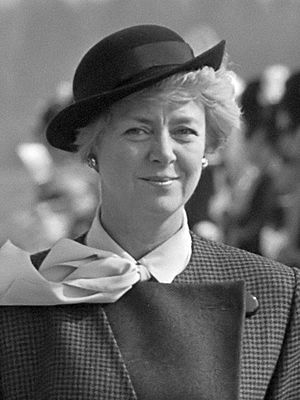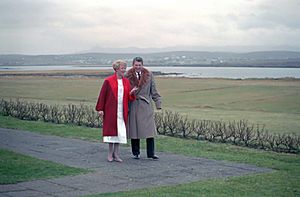Vigdís Finnbogadóttir facts for kids
Quick facts for kids
Vigdís Finnbogadóttir
|
|
|---|---|

Vigdís in 1985
|
|
| 4th President of Iceland | |
| In office 1 August 1980 – 1 August 1996 |
|
| Prime Minister | Gunnar Thoroddsen Steingrímur Hermannsson Þorsteinn Pálsson Davíð Oddsson |
| Preceded by | Kristján Eldjárn |
| Succeeded by | Ólafur Ragnar Grímsson |
| Personal details | |
| Born | 15 April 1930 Reykjavík, Iceland |
| Spouse |
Ragnar Arinbjarnar
(m. 1954; div. 1961) |
| Children | 1 |
| Alma mater | University of Paris University of Grenoble University of Copenhagen University of Iceland |
Vigdís Finnbogadóttir (born 15 April 1930) is an amazing Icelandic leader. She was the fourth president of Iceland from 1980 to 1996. This made her the first woman in the world to be chosen as president by a democratic vote.
Vigdís served for 16 years, which means she was the longest-serving elected female head of state in history. Today, she is a UNESCO Goodwill Ambassador. This means she helps promote important causes for UNESCO, like language and culture. She is also a member of the Club of Madrid, a group of former democratic presidents and prime ministers.
Contents
Early Life and Education
Vigdís was born in Reykjavík, Iceland, on April 15, 1930. Her father was an engineer, and her mother was a nurse.
She loved learning and studied at several universities. She went to the University of Grenoble and later to the Sorbonne in Paris. There, she focused on English and French literature, especially plays. She finished her studies in 1953.
Early Career and Activism
After her studies, Vigdís became involved in theatre. She helped start a theatre group and worked on translating French plays. She also studied theatre history at the University of Copenhagen.
Vigdís was a strong believer in peace. In the 1960s and 1970s, she joined protests against the United States military presence in Iceland. In 1972, she became the first single woman in Iceland to adopt a child, showing her independent spirit.
She also became a familiar face across Iceland. Starting in 1972, she taught French lessons on television for RÚV, the national broadcasting service. In the same year, she became the artistic director of the Reykjavík Theatre Company. Before becoming president, she also taught French at colleges and the University of Iceland. She even worked as a tour guide and later led the Icelandic Tourist Bureau.
Becoming President (1980–1996)
Vigdís decided to run for president in 1980. She wanted to show that women could lead political campaigns. Many people thought she wouldn't win.
On June 29, 1980, Vigdís won the election with 33.6% of the votes. She became the fourth president of Iceland on August 1, 1980. This was a huge moment because she was the first woman ever to be democratically elected as a country's leader. After her election, more women became involved in politics in Iceland.
Key Moments as President
Vigdís was re-elected without anyone running against her in 1984.
A very important event during her presidency was the Reykjavík Summit in October 1986. This was a meeting between American President Ronald Reagan and Soviet President Mikhail Gorbachev. This meeting helped improve relations between the two countries and brought the Cold War closer to an end.
In 1988, Vigdís faced a challenger in the election for the first time. But she won by a landslide, getting 92.7% of the votes. She was re-elected again without opposition in 1992.

Vigdís's Impact
Even though the Icelandic presidency is mostly a ceremonial role, Vigdís made it very active. She used her position to represent Iceland and strengthen the country's identity through cultural projects.
Vigdís is a strong environmentalist. She used her presidency to speak up for environmental issues. She led a campaign to plant more trees in Iceland and worked to prevent topsoil loss. She is also a pacifist, meaning she believes in peace and avoiding war. She even called herself a "peace person." Vigdís also supported gay rights during her time as president.
In 1994, Vigdís faced a tough decision about Iceland joining the European Economic Area. Many people in Iceland were against it. But Vigdís supported closer ties with Europe. She decided not to use her presidential veto to block the agreement.
Vigdís chose not to run for a fifth term. Her time as president ended in August 1996. She served for 16 years, making her the longest-serving female elected head of state in history.
After the Presidency
After leaving office, Vigdís continued to be a global leader. In 1996, she became the first chair of the Council of Women World Leaders. From 1997 to 2001, she also chaired the World Commission on the Ethics in Scientific Knowledge and Technology.
Since 1998, Vigdís has been a UNESCO Goodwill Ambassador for languages. She believes that understanding different languages helps people understand each other better. She also continues to advocate for peace. She has spoken about the importance of countries talking to each other to solve problems, just like during the Reykjavík Summit.
Vigdís is still a member of the Club of Madrid, where she shares her experience with other former world leaders.
Honours and Awards
Vigdís has received many awards and honours from Iceland and other countries for her important work.
National Honours
 Iceland: Grand Cross with Collar of the Order of the Falcon (1 August 1980)
Iceland: Grand Cross with Collar of the Order of the Falcon (1 August 1980)
Foreign Honours
 Denmark:
Denmark:
 Knight of the Order of the Elephant (25 February 1981)
Knight of the Order of the Elephant (25 February 1981)
 Sweden:
Sweden:
 Knight with Collar of the Royal Order of the Seraphim (8 October 1981; collar 1987)
Knight with Collar of the Royal Order of the Seraphim (8 October 1981; collar 1987)
 Norway:
Norway:
 Finland:
Finland:
 Netherlands:
Netherlands:
 Spain:
Spain:
 Knight Grand Cross with Collar of the Order of Charles III (11 September 1985)
Knight Grand Cross with Collar of the Order of Charles III (11 September 1985)
 United Kingdom:
United Kingdom:
 Honorary Dame Grand Cross of the Order of the Bath (25 June 1990)
Honorary Dame Grand Cross of the Order of the Bath (25 June 1990)
Honorary Degrees
Vigdís has also received special degrees from universities, recognizing her achievements:
- Université Bordeaux Montaigne, France (1987)
- University of Trondheim, Norway (1993)
See also
 In Spanish: Vigdís Finnbogadóttir para niños
In Spanish: Vigdís Finnbogadóttir para niños
- List of the first women holders of political offices

